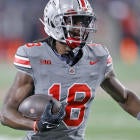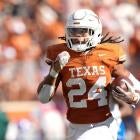Need Fantasy Football draft advice? Talk to CBS Sports on your Google Assistant to get insights on the best sleepers and to help decide between players. Just start with, "Hey Google, talk to CBS Sports."
AD. Beast Mode. Shady.
All three have cool nicknames and are established Fantasy rushers, but Adrian Peterson, Marshawn Lynch and LeSean McCoy are rare players expected to fill decent-to-major roles in their offenses while also over the age of 30.
What matters more, their age or their workload?
A long time ago on a screen probably much larger than the one you're reading this on right now, I began researching when running backs were due to break down. Many people simply assume a running back slows down whenever he turns 30, but it has more to do with how a player's body holds up following years and years of carries, catches and injuries.
How do I know? First, I took the total number of carries a running back had over his career, including the postseason. Most of those runs involve physical contact that can wear a running back down over time. I then took the total number of receptions a running back had, but divided that number by three because the physical contact involved on a catch isn't usually as direct or punishing as that on a carry.
I took both numbers and added them to create a Total Evaluation Number (or TEN for short). Most running backs with a TEN of 2,100 are at significant risk for a drop-off in production, if not a serious injury.
But ... I said most.
The one outlier involves running backs with Hall of Fame qualities. Some of the legends of our game grossly exceeded the 2,100 number. The great ones find a way!
Emmitt Smith (4,214), Walter Payton (3,845), LaDainian Tomlinson (3,293), Edgerrin James (2,988) and Marshall Faulk (2,800) are some examples from obvious studs who were really good for a really long time — and their TEN from before their respective breakdowns prove it.
Are Lynch, McCoy and Peterson future Hall of Famers? All three have topped 10,000 career rush yards. McCoy and Lynch are still just over 2,000 yards away from being even close to the top-15 in all-time rushing. Frank Gore, on the other hand, is already fifth on the all-time list and can move into fourth by running for 76 yards this season. Not that anyone's clamoring for Gore this year.
Here are the running backs who you need to worry about slowing down in 2018:
| Running back | Career carries | Career rec. | TEN | Major injury | Week 1 age |
| LeGarrette Blount | 1,481 | 55 | 1,499 | | 31 |
| Frank Gore | 3,366 | 461 | 3,519  |  | 35 |
| Chris Ivory | 1,135 | 94 | 1,166 | | 30 |
| Marshawn Lynch | 2,544 | 284 | 2,638  | | 32 |
| LeSean McCoy | 2,242 | 456 | 2,394  | | 30 |
| DeMarco Murray | 1,648 | 311 | 1,751 | | 30 |
| Adrian Peterson | 2,690 | 258 | 2,776  |  | 33 |
| Darren Sproles | 746 | 576 | 938 |  | 35 |
| Jonathan Stewart | 1,800 | 171 | 1,857 |  | 31 |
Rushers in the Danger Zone
- Problems: Older than everyone ... Expected to settle into part-time role with the Dolphins after racking up at least 255 carries in each of his previous seven seasons ... Has been below 4.0 yards per carry for three straight seasons.
- Can he overcome? This figures to be the year Fantasy owners write off Gore. While he'll compete for playing time in Miami's backfield this summer, Kenyan Drake figures to be the primary back with rookie Kalen Ballage fighting for snaps. Gore is a longshot to average even 10 touches per game, much less the 16.3 he has averaged since 2015.
- Feel-good draft spot: Round 15-plus
- Problems: Peterson signed with Washington and looked like a physical runner and definitely not a speedster in his first taste of preseason action. The Redskins are his third different team in two seasons ... Averaged just 3.4 yards per carry and scored twice in 10 games last season. Five of the games featured Peterson getting at least 14 carries. ... Peterson's last two seasons ended because of injury.
- Can he overcome? In order for Peterson to be good for Fantasy again he needs to find the end zone frequently while still getting 15-plus touches per week. With the Redskins, this is possible, but any week where he doesn't score will probably result in a sub-10-point Fantasy outing. Don't overrate him.
- Feel-good draft spot: Round 9 in non-PPR, Round 10 in PPR
- Problems: Came out of retirement and averaged 13.8 carries in his age-31 season, though he did post a 4.3 rushing average ... Does not seem to be in position to grossly improve on that rush attempt average with the Raiders adding Doug Martin to the backfield ... Had over 100 yards twice last season -- got to 101 twice. Lynch was under 80 yards in 12 other games.
- Can he overcome? Lynch ran aggressively and really turned up the juice late in the season with 15-plus carries in five of his past six (4.6 yards per carry). He also looked sharp on a long touchdown run in the preseason that was called back by a lame penalty. Jon Gruden's track record suggests he'll use multiple backs but lean on one to do most of the work, and Lynch is best suited to be that guy. Perhaps the lack of work for most of last season combined with his year out of football gives Lynch just enough gas in the tank to hammer defenses for one more season. His O-line is still solid and his offense should be fairly explosive.
- Feel-good draft spot: Round 6
- Problems: McCoy is in a precarious position. Not only might he face charges stemming from an off-field incident at his house in Georgia, but the offense he's in is transitioning to a new scheme with inexperienced quarterbacks, a weak receiving corps and only two returning starters to the offensive line. Not a great situation for a back coming off a 306-carry campaign (with a low-for-him 4.0 rushing average).
- Can he overcome? There will be a heavy reliance on McCoy given the lack of quality alternatives in Buffalo's offense. That's a double-edged sword because he's officially a risk to break down. Peep the Bills' early-season schedule -- Shady doesn't get a decent matchup until Week 5 vs. the Titans. It's hard to find positives in McCoy's outlook.
- Feel-good draft spot: Round 4, though many will be happy to get him in Round 3.
Next Up To Break Down
- Jonathan Stewart, NYG (TEN of 1,857): Expected to be Saquon Barkley's backup in New York, Stewart is unlikely to get much work unless Barkley misses time. Stewart has averaged 3.6 yards per carry in his past two seasons with the Panthers.
- LeGarrette Blount, DET (TEN of 1,499): No one's expecting much from Blount as part of the Lions' rushing unit. Frankly it would be surprising if he was used as much this year as he was last year.
- Mark Ingram, NO (TEN of 1,446): A four-game suspension should end a two-year streak of amassing over 200 carries. It might even help Ingram buy a little more time two or three years from now. Ingram's role figures to be up in the air while the Saints begin the season without him. Most folks would take him in Round 5, but that seems like too big a price to pay for a guy you won't have for five of the first six weeks of the season.
- Le'Veon Bell, PIT (TEN of 1,418): Believe it or not, Bell is starting to inch closer to being at-risk. Maybe the Steelers know it and plan on leaning on him a lot this season, then let him go in free agency. For now, Bell remains in Fantasy's good graces and will be a consensus top-three pick.
What sleepers should you snatch in your draft? And what big-name running back could ruin your season? Visit SportsLine now to get Fantasy Football cheat sheets from the model that called Alvin Kamara's huge breakout last season and find out.





























